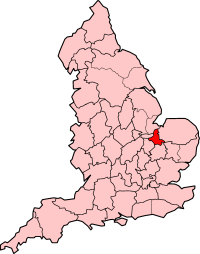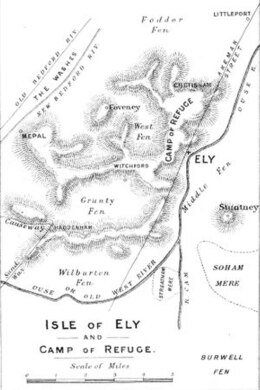Isle of Ely
| Isle of Ely | |
|---|---|
 | |
| Area | |
| • 1891 | 239,259 acres (968.2 km2) |
| • 1961 | 239,951 acres (971.0 km2) |
| • Coordinates | 52°24′N0°15.5′E/ 52.400°N 0.2583°E |
| Population | |
| • 1891 | 63,861 |
| • 1961 | 89,180 |
| History | |
| • Origin | Liberty of Ely |
| • Created | 1889 |
| • Abolished | 1965 |
| • Succeeded by | Cambridgeshire and Isle of Ely |
| Status | Administrative county (within Cambridgeshire) |
| Government | Isle of Ely County Council |
| •HQ | County Hall,March |
 | |
TheIsle of Ely(/ˈiːli/) is a historic region around the city ofElyinCambridgeshire,England.Between 1889 and 1965, it formed anadministrative county.
Etymology
[edit]Its name has been said to mean "island ofeels",a reference to the creatures that were often caught in the local rivers for food. This etymology was first recorded by theVenerable Bede.[1]
History
[edit]
Until the 17th century, the area was an island surrounded by a large area offenland,a type of swamp. It was coveted as an area easy to defend, and was controlled in the very early medieval period by theGyrwas,an Anglo-Saxon tribe. Upon their marriage in 652, Tondbert, a prince of the Gyrwas, presentedÆthelthryth(who became St. Æthelthryth), the daughter of KingAnna of the East Angles,with the Isle of Ely. She afterwards founded a monastery at Ely, which was destroyed by Viking raiders in 870, but was rebuilt and became a famousAbbeyandShrine.
The area's natural defences led to it playing a role in the military history of England. Following theNorman Conquest,the Isle became a refuge for Anglo-Saxon forces under EarlMorcar,Bishop Aethelwine of DurhamandHereward the Wakein 1071.[2]The area was taken byWilliam the Conqueroronly after a prolonged struggle.[3] The story ofTom Hickathriftis sometimes set around this period. In 1139civil warbroke out between the forces ofKing Stephenand theEmpress Matilda.Bishop Nigel of Ely,a supporter of Matilda, unsuccessfully tried to hold the Isle. In 1143Geoffrey de Mandevillerebelled against Stephen, and made his base in the Isle. Geoffrey was mortally wounded atBurwellin 1144. [4]
In 1216, during theFirst Barons' War,the Isle was unsuccessfully defended against the army ofKing John. Ely took part in thePeasants' Revoltof 1381. During the English Civil War the Isle of Ely was held for the parliamentarians. Troops from the garrison atWisbech Castlewere used in the siege ofCrowlandand parts of the Fens were flooded to prevent Royalist forces entering Norfolk from Lincolnshire. The Horseshoe sluice on the river atWisbechand the nearby castle and town defences were upgraded and cannon brought from Ely.[5]
The Fens were drained beginning in 1626 using a network of canals designed by Dutch experts.[6]Many Fenlanders were opposed to the draining as it deprived some of them of their traditional livelihood. Acts of vandalism on dykes, ditches, and sluices were common, but the draining was complete by the end of the century.[7]
Administration
[edit]
From 1109 until 1837, the Isle was under the jurisdiction of theBishop of Elywho appointed a Chief Justice of Ely and exercised temporal powers within the Liberty of Ely. This temporal jurisdiction originated in a charter granted by KingEdgarin 970, and confirmed byEdward the ConfessorandHenry Ito the abbot of Ely. The latter monarch established Ely as the seat of a bishop in 1109, creating the Isle of Ely acounty palatineunder the bishop. Anact of parliamentin 1535/6 ended the palatine status of the Isle, with all justices of the peace to be appointed byletters patentissued under the great seal and warrants to be issued in the king's name. However, the bishop retained exclusive jurisdiction in civil and criminal matters, and wascustos rotulorum.A chief bailiff was appointed for life by the bishop, and performed the functions ofhigh sheriffwithin the liberty, who also headed the government of the city of Ely.[8]
In July 1643Oliver Cromwellwas made governor of the isle.[9]
| Liberty of Ely Act 1837 | |
|---|---|
| Act of Parliament | |
 | |
| Long title | An Act to explain and amend an Act of the Sixth and Seventh Years of His late Majesty, for extinguishing the Secular Jurisdiction of the Archbishop of York and the Bishop of Ely in certain Liberties in the Counties of York, Nottingham, and Cambridge. |
| Citation | 7 Will. 4 & 1 Vict.c. 53 |
| Dates | |
| Royal assent | 15 July 1837 |
| Other legislation | |
| Repealed by | Statute Law Revision Act 1874 |
Status: Repealed | |
TheLiberty of Ely Act 1837(7 Will. 4 & 1 Vict.c. 53) ended the bishop's secular powers in the Isle. The area was declared a division ofCambridgeshire,with the right to appointjusticesrevested in the crown. Following the 1837 Act the Isle maintained separateQuarter Sessions,and formed its own constabulary.
Under theLocal Government Billof 1888, which proposed the introduction of electedcounty councils,the Isle was to form part of Cambridgeshire. Following the intervention of the localmember of parliament,Charles Selwyn,the Isle of Ely was constituted a separateadministrative countyin 1889. The county was small in terms of both area and population, and its abolition was proposed by theLocal Government Boundary Commissionin 1947.[10]The report of the LGBC was not acted upon, and the administrative county survived until 1965. Following the recommendations of theLocal Government Commission for England,on 1 April 1965 the bulk of the area was merged to formCambridgeshire and Isle of Ely,with theThorney Rural Districtgoing toHuntingdon and Peterborough.
Subdivisions
[edit]In 1894 the county was divided into county districts, with the rural districts beingEly Rural District,Thorney Rural District,Whittlesey Rural District,Wisbech Rural District,North Witchford Rural District,and the urban districts wereEly,March,WhittleseyandWisbech(the onlymunicipal borough). Whittlesey Rural district consisted of only one parish (Whittlesey Rural), which was added to Whittlesey urban district, in 1926.
TheIsle of Ely parliamentary constituencywas created as a two-member seat in theFirstandSecond Protectorate Parliamentsfrom 1654 to 1659. The constituency was re-created with a single seat in 1918. In the boundary changes of 1983 it was replaced by the new constituency ofNorth East Cambridgeshire.Original historical documents relating to the Isle of Ely are held byCambridgeshire Archives and Local Studiesat the County Record Office in Ely.
Medieval parishes
[edit]Chapelriesare listed in italics. Parishes are listed byhundred.
| Hundred | Parishes |
|---|---|
| Ely | Downham•Ely St Mary(Chettisham) •Ely Trinity(Stuntney) •Littleport |
| North Witchford | Chatteris•Doddington(Benwick•March) •Whittlesey St Andrew•Whittlesey St Mary(Eastrea•Eldernell) |
| South Witchford | Coveney(Manea) •Haddenham•Mepal•Stretham(Thetford) •Sutton•Wentworth•Wilburton•Witcham•Witchford |
| Wisbech | Elm•Leverington(Parson Drove) •Newton(Newton St Mary) •Thorney•Tydd St Giles•Wisbech St Peter(Guyhirn•Murrow•Wisbech St Mary) |
Marquessate
[edit]The title Marquess of the Isle of Ely was created in thePeerage of Great BritainforPrince Frederick.The title ofDuke of Edinburghwas first created on 26 July 1726 by KingGeorge I,who bestowed it on his grandson Prince Frederick, who becamePrince of Walesthe following year. The subsidiary titles of the dukedom were Baron of Snowdon, in the County of Caernarvon; Viscount of Launceston, in the County of Cornwall; Earl of Eltham, in the County of Kent;[11]and Marquess of the Isle of Ely. Themarquessatewas apparently erroneouslygazettedas Marquess of theIsle of Wight[11]although Marquess of the Isle of Ely was the intended title. In later editions of theLondon Gazettethe Duke is referred to as the Marquess of the Isle of Ely.[12][13]Upon Frederick's death, the titles were inherited by his son Prince George. When he becameGeorge IIIin 1760, the titles "merged into the Crown",and ceased to exist.
Mining
[edit]Coproliteswere mined in the area in the 1800s for their rich phosphate content.[14][15]
References
[edit]- ^Historia Ecclesiastica,IV:XIX
- ^Hereward and the Isle of Ely,BBC History, accessed 6 January 2008
- ^The taking of Ely,BBC History, accessed 6 January 2008
- ^The Isle of Ely and Civil War:Trevor Bevis,Hereward of the Fens,(Cambridgeshire Genealogy), accessed 6 January 2008
- ^"Wisbech and the civil war".Retrieved12 January2019.
- ^"Cambridgeshire History & the Isle of Ely Timeline".Archived fromthe originalon 17 June 2016.Retrieved25 April2013.
- ^"The Draining of the Fens".Visit Ely. Archived fromthe originalon 4 June 2016.Retrieved10 March2015.
- ^Lewis, Samuel,Topographical Dictionary of England,Vol. II, London 1831
- ^"Fenland riots".elystandard.co.uk.7 December 2006. Archived fromthe originalon 13 January 2019.Retrieved12 January2019.
- ^"Town and county boundaries - First decisions of the Commission",The Times,2 May 1947
- ^ab"No. 6494".The London Gazette.12 July 1726. p. 1.
- ^"No. 6741".The London Gazette.4 January 1728. p. 2.
- ^"No. 9050".The London Gazette.16 April 1751. p. 1.
- ^Grove R (1976)."Coprolite Mining in Cambridgeshire"(PDF).Agricultural History Review.24(1). Archived fromthe original(PDF)on 9 March 2006.
- ^"Cambridgeshire - The Coprolite Mining Industry".EnglandGenWeb. 13 January 2000.
Further reading
[edit]- Fairweather, Janet (2005). "Introduction".Liber Eliensis.Translated by Fairweather, Janet. Woodbridge, UK: Boydell Press. pp. xiii–xliv.ISBN978-1-84383-015-3.

